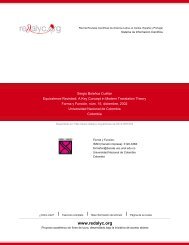Redalyc.Volcanismo de sin-rift de la Cuenca Neuquina, Argentina ...
Redalyc.Volcanismo de sin-rift de la Cuenca Neuquina, Argentina ...
Redalyc.Volcanismo de sin-rift de la Cuenca Neuquina, Argentina ...
You also want an ePaper? Increase the reach of your titles
YUMPU automatically turns print PDFs into web optimized ePapers that Google loves.
D’Elia et al./ An<strong>de</strong>an Geology 39 (1): 106-132, 2012<br />
<strong>de</strong> manera ais<strong>la</strong>da o en contacto, con ausencia <strong>de</strong><br />
<br />
<br />
están constituidos <strong>de</strong> cuarzo, fel<strong>de</strong>spato potásico,<br />
p<strong>la</strong>gioc<strong>la</strong>sa y biotita, mientras que los litoc<strong>la</strong>stos<br />
<br />
<br />
escaso volumen y espesor se han preservado con<br />
<br />
<br />
<br />
Las ignimbritas con gran volumen y espesor están<br />
incipiente o parcialmente soldadas (sensu Smith,<br />
<br />
<br />
<br />
-<br />
<br />
el espesor fue fundamental para retener el calor,<br />
generando <strong>de</strong>svitrificación a alta temperatura. En<br />
estos casos, se observan sectores que muestran un<br />
<br />
<br />
<br />
magmática, <strong>la</strong>s litofacies lávicas y piroclásticas se<br />
extien<strong>de</strong>n <strong>de</strong>s<strong>de</strong> los términos menos evolucionados<br />
<strong>de</strong>l sistema, constituidos por basaltos y an<strong>de</strong>sitas<br />
basálticas, hasta los términos más evolucionados,<br />
<strong>la</strong>s riolitas. La presencia <strong>de</strong> minerales hidratados<br />
primarios (hornblenda y biotita) en <strong>la</strong>s diferentes<br />
litofacies evolucionadas es indicativa <strong>de</strong> magmas<br />
originarios con concentraciones <strong>de</strong> agua iguales o<br />
<br />
participación <strong>de</strong> materiales piroclásticos en gran<strong>de</strong>s<br />
proporciones y <strong>la</strong>s varieda<strong>de</strong>s texturales registradas<br />
<br />
<br />
<br />
<br />
piroclásticas y cuerpos volcánicos discriminados,<br />
<strong>de</strong>s<strong>de</strong> intrusiones someras hasta co<strong>la</strong>das <strong>de</strong> <strong>la</strong>vas, y<br />
<strong>la</strong>s texturas <strong>de</strong> <strong>de</strong>sequilibrio (e.g., cribadas gruesa<br />
en p<strong>la</strong>gioc<strong>la</strong>sa, bor<strong>de</strong>s reabsorbidos <strong>de</strong> cristales<br />
y texturas manteadas <strong>de</strong> opacos en hornblenda y<br />
biotita) asociadas a diferentes grados <strong>de</strong> <strong>de</strong>scom-<br />
<br />
<br />
un sistema <strong>de</strong> ascenso complejo con variaciones en<br />
el mecanismo eruptivo, en el volumen y en <strong>la</strong> tasa<br />
<strong>de</strong> ascenso <strong>de</strong> los magmas originarios.<br />
4.2. Facies <strong>de</strong> alteración <strong>de</strong> <strong>la</strong>s rocas lávicas y<br />
piroclásticas Precuyanas<br />
<br />
<br />
rocas lávicas y piroclásticas <strong>de</strong> <strong>la</strong> secuencia <strong>de</strong>l Ciclo<br />
Precuyano resi<strong>de</strong> en el diferente grado <strong>de</strong> alteración<br />
composicional que presentan. Esta cuestión adquiere<br />
especial significación al consi<strong>de</strong>rar hasta qué punto<br />
los procesos inherentes al volcanismo modificaron<br />
<br />
<br />
procesos extensionales <strong>de</strong> <strong>la</strong> <strong>Cuenca</strong> <strong>Neuquina</strong>. El<br />
estudio <strong>de</strong> <strong>la</strong> distribución <strong>la</strong>teral y vertical <strong>de</strong> <strong>la</strong>s<br />
unida<strong>de</strong>s <strong>de</strong>l relleno <strong>de</strong> <strong>sin</strong>-<strong>rift</strong>, conjuntamente con<br />
el control petrográfico y los análisis <strong>de</strong> difracción <strong>de</strong><br />
<br />
<strong>de</strong> alteración (sensu<br />
et al.,<br />
<br />
IV) Silicificación, V) Alteración Sericita-Cuarzo,<br />
<br />
<br />
<br />
<br />
5B) se encuentra afectando <strong>la</strong>vas autobrechadas<br />
y minoritariamente <strong>la</strong>vas coherentes <strong>de</strong> composi-<br />
<br />
sugieren temperaturas<br />
<br />
<br />
se encuentra espacial y<br />
composicionalmente asociada a <strong>la</strong>s facies <strong>de</strong> <strong>la</strong>vas<br />
ciones<br />
<strong>sin</strong>-volcánicas <strong>de</strong> restringida circu<strong>la</strong>ción con<br />
<br />
<br />
<strong>de</strong> manera local-estratoligada, particu<strong>la</strong>rmente<br />
en los sectores basales <strong>de</strong> <strong>la</strong>s unida<strong>de</strong>s <strong>de</strong> flujos<br />
piroclásticos <strong>de</strong> gran espesor y distribución. Se<br />
caracteriza por texturas <strong>de</strong> reemp<strong>la</strong>zo <strong>de</strong> materiales<br />
<br />
<br />
<br />
reemp<strong>la</strong>zados principalmente por sericita, clorita<br />
<br />
<br />
sugieren una alteración <strong>de</strong> tipo <strong>de</strong>utérica por parte

















